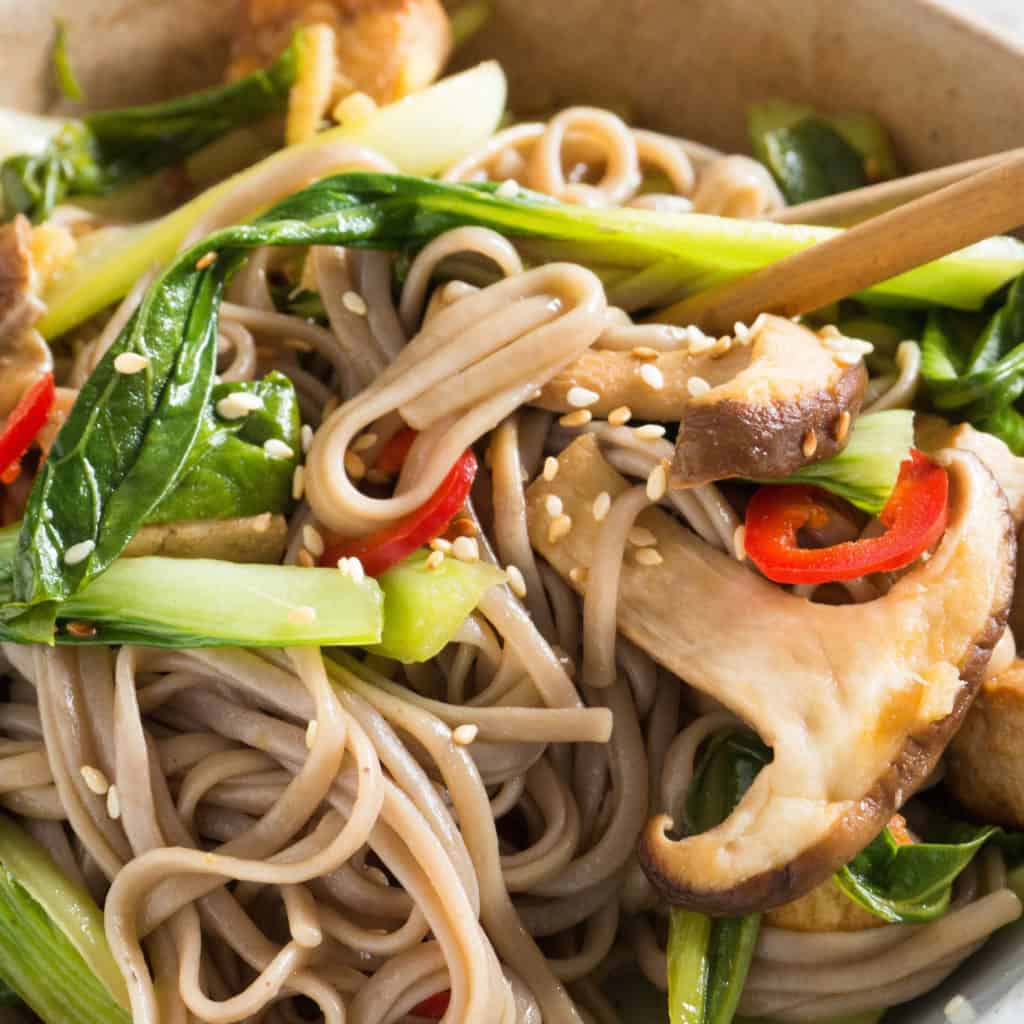
Sesame Noodles with Shitake Mushrooms and Pak Choi is a great dinner when you want something quick, easy, super tasty, hot and filling. It is ready in less than 30 minutes and super delicious.
Sesame Noodles with Shitake Mushrooms and Pak Choi is easy to medium and very quick to make from scratch.
You can find the full Sesame Noodles with Shitake Mushrooms and Pak Choi recipe here.
I adore Sesame Noodles with Shitake Mushrooms and Pak Choi for dinner when I want something quick and easy. However, they are also perfect for when you have guests around. Serve with Miso Soup with Tofu and Shitake Mushrooms.
Soba noodles are traditionally made of 100% buckwheat. Soba is Japanese for buckwheat (but can refer to any thin noodle in Japan). Check the ingredients on the packet and make sure that the noodles you buy are gluten-free. Many brands add wheat flour to soba noodles.
You can use dried shitake mushrooms just soak them in advance (and save the juice to add to the sauce instead of water in the recipe).
I use a large wok for this but you can also use a large frying pan. The heat should be quite high!
Preparation
Difficulty easy-medium
Preparation time 10 minutes
Cooking time 15 minutes
You can find the full Sesame Noodles with Shitake Mushrooms and Pak Choi recipe here.
Allergens
Sesame Noodles with Shitake Mushrooms and Pak Choi is gluten-free and vegan as well as…
Celery free
Coconut free
Garlic free
Lupin free
Mustard free
Nightshade free*
Onion free
Peanut free
Tree nut free
*For nightshade free leave out the chilli.
About
Shitake mushrooms are often referred to as ‘meaty’. This is perhaps because of their rather robust texture (particularly if they have been dried and re-hydrated). I do not think they are ‘meaty’ at all but what do I know I haven’t eaten meat in over 30 years… I like them, they taste great, are super versatile and reasonably priced too.
Shitake (often spelt shiitake) mushroom, lentinula edodes, is an edible mushroom native to East Asia, which is cultivated and consumed in many Asian countries (and across much of the rest of the world). It is considered a medicinal mushroom in some forms of traditional medicine.
Shitake grow in groups on the decaying wood of deciduous trees, particularly shii, chestnut, oak, maple, beech, sweetgum, poplar, hornbeam, ironwood, mulberry, and chinquapin. Its natural distribution includes warm and moist climates in southeast Asia.
The earliest written record of shitake cultivation is seen in the Records of Longquan County compiled by He Zhan in 1209. The 185-word description of shitake cultivation from that literature was later crossed-referenced many times and eventually adapted in a book by a Japanese horticulturist Satō Chūryō in 1796, the first book on shitake cultivation in Japan. The Japanese cultivated the mushroom by cutting shii trees with axes and placing the logs by trees that were already growing shiitake or contained shiitake spores.
Shitake mushrooms are now widely cultivated all over the world, and contribute about 25% of total yearly production of mushrooms. Commercially, shiitake mushrooms are typically grown in conditions similar to their natural environment on either artificial substrate or hardwood logs, such as oak.
100 grams of raw shitake mushrooms provide 34 kilo-calories and consist of 90% water, 7% carbohydrates, 2% protein and less than 1% fat. Raw shiitake mushrooms are a rich source (20% + of RDA) of vitmains B3, B5 and B6 and contain moderate levels of some dietary minerals. Like all mushrooms, shitakes produce vitamin D2 upon exposure of their internal ergosterol to ultraviolet B rays from sunlight or broadband UVB fluorescent tubes.
Soba noodles are traditionally made of 100% buckwheat. Soba is Japanese for buckwheat (but can refer to any thin noodle in Japan). Buckwheat is also a rather misleading name. It is not related to wheat and contains no gluten. Buckwheat (fagopyrum esculentum) is not a grass (as wheat is), it is related to sorrel, knotweed, and rhubarb. Buckwheat is also known as Japanese buckwheat and beach wheat.
Buckwheat seeds are rich in complex carbohydrates and it is often referred to as a pseudocereal. The cultivation of buckwheat declined sharply in the 20th century with the adoption of nitrogen fertiliser that decreased the yield of buckwheat and increased the productivity of other staples.
A 100 gram serving of buckwheat provides 343 kilo-calories dry or 92 kilo-calories cooked. Buckwheat is a good source of protein (20% + RDA), dietary fibre, four B vitamins and several dietary minerals. Content is especially high in niacin, magnesium, manganese and phosphorus (47 to 65% RDA).
Buckwheat is especially popular in Asia and eastern Europe. In Japan buckwheat (soba) noodles are very popular. In eastern Europe buckwheat is used to make blini and other types of pancake. Buckwheat is incredibly versatile and can also be used to make beer, whiskey and tea.